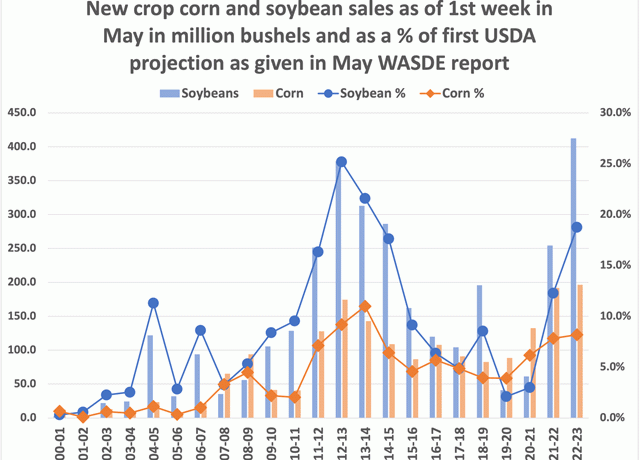Fundamentally Speaking
Corn Stocks-to-Use Ratio
Last week's USDA May WASDE report showed tighter corn stocks than had been expected though the 2023/24 carryout figure at 2.023 billion bushels (bb) is the highest in five seasons.
In its first look at the 2024/25 balance sheet, USDA indicated ending stocks next year will increase by 80 million bushels (mb) to 2.103 bb which will be the highest figure if it sticks since 2.220 bb back in the 2018/19 marketing year.
This year's stocks-to-use ratio at 13.8% is also the highest since the 2018/19 season, though the initial forecast for next year from the USDA increases to 14.2%.
What will be the situation in a few months, let's say when the USDA releases its November 2024 WASDE, six months down the road?
By that point we will have a better idea of how demand for the rest of this marketing year held up while the trade will also have a pretty good fix on the size of this year's crop which so far this spring is getting seeded at a below average pace.
P[L1] D[0x0] M[300x250] OOP[F] ADUNIT[] T[]
That will have a huge bearing on total supplies, forecasted consumption and of course price direction.
This graphic shows the USDA's old and new crop U.S. corn stocks-to-use ratios in the May WASDE report on the left-hand axis vs. the change in both the old and new crop U.S. corn stocks-to-use ratios from the May to November WASDE reports on the right-hand axis.
For old crop there is not usually much of change in the stocks-to-use ratio for the May to November reports as demand at that point has been locked in for 8 of the 12 months of the marketing year.
We surmise that the makings of a good crop probably results in the lowering of the old crop stocks-to-use ratio from May to November as that is usually a price negative factor that would encourage perhaps a slight increase in old crop demand.
Conversely, if the new crop outlook is poor, that usually results in higher prices suppressing demand that would result in a higher stocks-to-use ratio in November than in May.
Since 2000 the average change in the old crop corn ending stocks-to-use ratio from the May to November WASDE report is up 0.2%.
The largest decline was in 2006 of 2.7% and the largest increase was a year later in 2007 of up 3.5%.
The change in the new crop stocks-to-use ratio from May to November hinges even more on the new crop outlook as since 2000 the average change in the new crop corn ending stocks-to-use ratio from the May to November WASDE report is down 0.9%.
The largest decline was in 2020 of 10.9% and the largest increase was in 2004 of up 9.6%.
Note that this year's May 2024 WASDE report showing the new crop U.S. corn stocks-to-use ratio is up 0.4% from the old crop May figure which along with May 2022, May 2010 and May 2007, are the smallest differentials between the May WASDE old and new crop corn stocks-to-use ratios.
(c) Copyright 2024 DTN, LLC. All rights reserved.






Comments
To comment, please Log In or Join our Community .